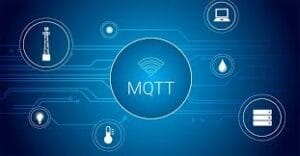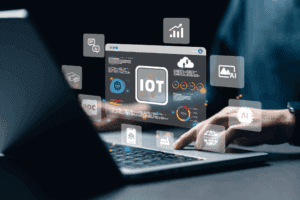Why AI Can’t Control IoT Devices Yet
Generative AI is evolving fast—from ChatGPT to Claude to DeepSeek—enabling machines to write, code, and analyze. But there's one major limitation:
AI can't yet act on the physical world.
Want to turn on a light? Adjust your factory machine? Most AI models are still confined to the virtual realm.
That’s where MCP2MQTT comes in. This open-source bridge connects AI models to real-world IoT devices using MCP over MQTT, making it possible to control physical environments in real time.
In this article, we’ll show how tools like EMQX MQTT broker, MQTT IoT protocols, and MCP2MQTT form the foundation of AIoT control systems—and how ZedIoT can help you deploy it.
What Is Model Context Protocol (MCP) and How It Connects AI to the Real World
✦ What Is MCP?
Model Context Protocol (MCP), proposed by Anthropic and the open-source community, is a universal protocol designed to let AI models call tools or control external systems in a structured way.
Unlike traditional HTTP APIs or programming languages, MCP aligns closely with AI’s contextual understanding of natural language.
Its features include:
- ✅ JSON Schema-based, with clearly defined actions and parameters
- ✅ Compatible with LLM tool use/function calling
- ✅ Acts as a universal bridge for AI agents to control the real world
- ✅ Suitable for private models, local deployments, and low-resource environments
Think of MCP as the “remote control protocol” for AI—it teaches models to issue structured commands that machines can understand.
MQTT: The Standard Protocol for Controlling IoT Devices
If MCP is the language of AI, then MQTT is the language of IoT.
MQTT (Message Queuing Telemetry Transport) is a lightweight publish-subscribe protocol used in low-bandwidth, power-sensitive IoT environments. Almost all smart sensors and actuators support MQTT.
Key features:
- ✅ Pub/Sub pattern for wide-scale distribution
- ✅ Low latency, small payloads
- ✅ Multilingual SDKs for easy integration
- ✅ QOS for reliable communication
- ✅ Supports cloud, edge, and on-prem deployment
MCP2MQTT: Bridging MCP Over MQTT for AIoT Control
MCP provides structured semantic intent. MQTT delivers actual device control. When combined, they enable AI to fully execute: “Understand → Decide → Control.”
This is the vision behind EMQX’s MCP over MQTT, and the open-source mcp2mqtt project—creating an end-to-end loop:
Natural Language → LLM → MCP Command → MQTT Transmission → IoT Execution → Feedback → LLM Adjustment
This closed loop brings AIoT from “perception” to “proactive control.”
How MCP2MQTT Works: Middleware Between AI and MQTT Broker
MCP2MQTT is the open-source bridge between LLMs and devices.
It translates AI-generated MCP commands into MQTT-compatible messages.
🧩 How It Works
Think of MCP2MQTT as a protocol converter connecting:
- Input: JSON MCP commands from models or agents
- Output: MQTT control messages published to specific topics
- Feedback: Converts MQTT responses into AI-readable JSON
Diagram:
flowchart TD A["User Input"] --> B["LLM Generates MCP"] B --> C["MCP2MQTT Middleware"] C --> D["MQTT Broker"] D --> E["IoT Device"] E --> F["Device Feedback"] F --> D D --> G["MCP2MQTT Converts Back"] G --> H["LLM Interprets Feedback"]
Real-World Example: AI Controls an AC via MCP2MQTT
1️⃣ User:
"Turn on the AC in Meeting Room A and set temperature to 22°C."
2️⃣ LLM generates MCP:
{ "tool": "ac_controller", "action": "set_temperature", "params": { "location": "Meeting Room A", "temperature": 22 } }3️⃣ MCP2MQTT translates:
{ "topic": "building/meetingroomA/ac", "payload": { "cmd": "SET_TEMP", "value": 22 } }4️⃣ AC receives via MQTT and executes.
5️⃣ Device reports status:
{ "topic": "building/meetingroomA/ac/status", "payload": { "temperature": 22, "status": "on" } }6️⃣ MCP2MQTT wraps the status and returns it to the LLM.
Core Features of MCP2MQTT for IoT Integration
✅ 1. Flexible Topic Mapping
Configure how MCP command fields are mapped to MQTT topics and payloads, adapting to device naming conventions.
✅ 2. Two-Way Communication
Built-in callback channels parse device feedback into LLM-readable JSON.
✅ 3. Plugin Architecture
Extend via:
- Custom protocol plugins
- Multi-model sharing
- Auth token security via API Gateway
AIoT Use Cases Powered by MCP2MQTT and EMQX
| Sector | AI Control Capability | Business Value |
|---|---|---|
| Smart Office | Lights / AC / Curtains / Room Booking | Natural language control improves productivity |
| Smart Home | Voice control over all appliances | No app needed—AI speaks directly to devices |
| Industrial | Robot and workflow automation | AI agent optimizes operations, reduces manual effort |
| Smart Farming | Irrigation / Climate / Soil Monitoring | AI inference adjusts controls to improve yield |
| Healthcare | Call systems / Comfort Controls | Seniors interact naturally, no learning curve |
Getting Started with MCP2MQTT + EMQX
✅ Deployment Steps
Source: (https://github.com/mcp2everything/mcp2mqtt)
1️⃣ Start MQTT Broker (EMQX Recommended)
docker run -d --name emqx -p 1883:1883 -p 8083:8083 emqx/emqx:latest2️⃣ Configure MCP2MQTT Mapping (config.yaml)
mqtt:
broker: "mqtt://localhost:1883"
topics:
- topic: "building/+/ac"
mcp_tool: "ac_controller"
mcp_action: "set_temperature"3️⃣ Start MCP2MQTT
git clone https://github.com/mcp2everything/mcp2mqtt.git
cd mcp2mqtt
pip install -r requirements.txt
python mcp2mqtt.pyBuilding Enterprise AIoT Systems with EMQX
flowchart TD A[AI Model/Agent] -->|MCP JSON| B[MCP2MQTT] B -->|MQTT Command| C[EMQX Broker] C -->|Device Command| D[Smart Devices] D -->|Status Feedback| C C -->|Event Parsing| E[EMQX Rules Engine] E -->|Callback| B B -->|Feedback| A
Architecture Benefits:
- High Concurrency: EMQX supports millions of connections
- Stream Processing: EMQX Rules Engine handles complex events
- Open Integrations: Works with LangChain, Dify, Flowise
- Feedback Loop: AI receives real-time state updates for reasoning
Technical Benefits & Roadmap of MCP2MQTT
| Dimension | Strength | Future Vision |
|---|---|---|
| Dev Workflow | AI devs use natural language only | Build Agent Toolchains (e.g. ToolBench + MCP2MQTT) |
| Protocol | MQTT fits IoT needs perfectly | Add support for OPC UA, Modbus, etc. |
| Ecosystem | Integrates with EMQX, LangChain, etc. | Toward edge AI control platforms |
| Usability | Zero-code setup | Strengthen security with TLS, tokens, permissions |
Future Evolution Possibilities: Local Agents, Protocols, Security with MCP2MQTT and EMQX
- MCP Tool Standardization (via OpenAgent, LangChain)
- Edge AI Deployment (e.g. in routers, cameras)
- Intent Recognition + Device Graphs
- Integration with Enterprise Middleware (security, monitoring)
Final Thoughts: MCP2MQTT Is the First Step Toward AI-Driven IoT
From chat to action, from natural language to physical control—MCP2MQTT enables real-world AI execution.
With MCP2MQTT, enterprises can now break the boundary between digital intelligence and physical action.
Whether you’re using MQTT IoT networks, deploying an EMQX MQTT broker, or designing a full-stack AIoT system, this open-source bridge empowers large models to issue structured, actionable commands.
ZedIoT offers tailored consulting and system integration to help your organization deploy MCP over MQTT pipelines, integrate MCP2MQTT, and connect large models to your hardware.
From natural language to real-world execution—this is where AI meets IoT.
📚 Related Resources
- EMQX: MCP Over MQTT Intro
- GitHub: MCP2MQTT
- LangChain Tool Executor Docs
- AI + IoT Use Cases
- Building an AI Control Center with MCP + IoT Platform: How Does MCP Work in IoT Systems?
- Dify MCP Server: Building Modular AI System Applications Like Lego Bricks
- MCP(Model Context Protocol): The Universal Protocol Bridging AI with the Real World
📌 FAQs About MCP2MQTT, MQTT, and AIoT Control
1. What is MCP2MQTT, and how does it work?
mcp2mqtt is an open-source middleware that translates MCP protocol commands from AI models into MQTT messages. It acts as a bridge between AI logic and IoT hardware, enabling real-time control through MQTT brokers like EMQX.
2. What is MCP over MQTT?
MCP over MQTT refers to the architecture where AI-generated Model Context Protocol (MCP) commands are transmitted via the MQTT protocol. This enables structured, semantic AI instructions to be interpreted by IoT systems.
3. Why use EMQX as your MQTT broker for AIoT?
EMQX is a high-performance MQTT broker capable of handling millions of concurrent IoT connections. It integrates seamlessly with mcp2mqtt and supports rule engines, WebSocket, and real-time message routing.
4. Can I use MCP2MQTT with any IoT device?
Yes. As long as your IoT device supports MQTT, you can use mcp2mqtt to relay AI-generated control instructions to the device. Configuration is done via flexible YAML mappings.
5. How can ZedIoT help implement MCP2MQTT solutions?
ZedIoT provides consulting, integration, and deployment services for AIoT systems. We help enterprises connect large language models to IoT devices using mcp2mqtt, EMQX, and custom hardware interfaces.


